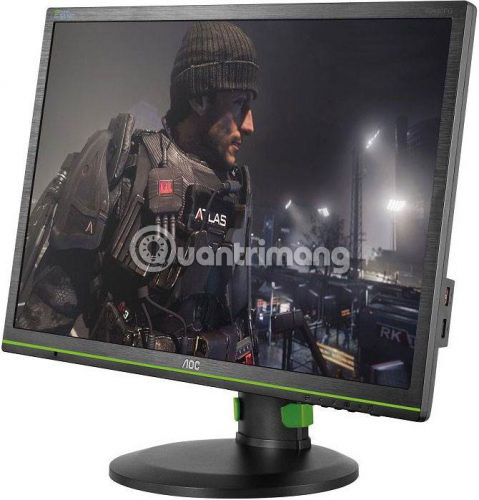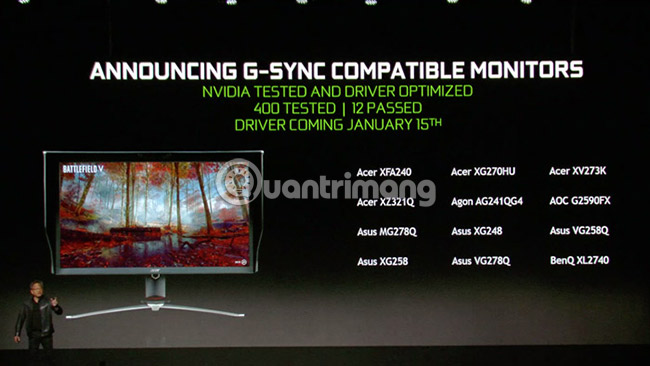All you need to know about Nvidia's G-Sync technology
G-Sync is mentioned by many people and wants to be owned, but G-Sync is really nothing but everyone knows. Nvidia's not-so-secret weapon was cheaper than a few years ago, so now is a good time to think about whether to invest in G-Sync.
Today's article will incorporate everything you need to know about Nvidia's G-Sync technology.
How does G-Sync work?
To understand G-Sync, we must first understand V-sync and its limitations.
You may be more familiar with V-sync. This technology limits the frame rate of the game to be equal to the screen refresh rate. So if there is a 60hz, 75hz or 120hz screen, the frame rate on a game will also reach a maximum of 60hz, 75hz or 120hz respectively. This is very important to prevent the tearing screen phenomenon, ie broken lines appear on the screen during game play, when the GPU is displaying frames at a different speed than the screen. form.
Computers today arrange images to be sent to the screen using double buffering or triple buffering techniques. Basically prepare one or two subsequent frames while another frame is being displayed on the screen. To avoid doing 'tearing up', V-sync will cause a delay to ensure that the screen is ready for the next frame (lag phenomenon).
 All you need to know about Nvidia's G-Sync technology Picture 1
All you need to know about Nvidia's G-Sync technology Picture 1
In addition, if only double buffering is used (like most games), users can see serious FPS drop (FPS drop). This is a problem when the graphics card is not strong enough to output at a continuous high frame rate in a certain game.
The information is a bit long, but it helps explain G-Sync much faster.
A monitor equipped with G-Sync technology is capable of creating VRR (Variable Refresh Rate), constantly adapting to Nvidia's GPU rendering rate (G-Sync is Nvidia's technology, so it's exclusive on Nvidia graphics card). This completely eliminates the 'tearing' phenomenon because the GPU frame rate never exceeds the refresh rate of the screen, eliminating the FPS drop phenomenon that appears on V-sync and reducing the level. input delay because the monitor no longer has to maintain buffering techniques.
Is G-Sync worth the price?
 All you need to know about Nvidia's G-Sync technology Picture 2
All you need to know about Nvidia's G-Sync technology Picture 2
First, it depends on the level of 'hardcore' of the gamer and the type of game to play. G-Sync creates low input delay, more stable performance and no "tearing".
If you own a high-end graphics card with regular V-sync feature, you will get the desired stable performance and frame rate, even on a G-Sync-free screen. There is still lag or input delay, but the severity of this depends on the screen being used. Manufacturers tend not to mention input delays when advertising their screens, but this handy site can help find the latency of the screen: https://displaylag.com/display- database /
G-Sync is now compatible with the FreeSync screen
 All you need to know about Nvidia's G-Sync technology Picture 3
All you need to know about Nvidia's G-Sync technology Picture 3
Nvidia has made a recent welcome move to make G-sync more accessible to gamers. In January 2019, Nvidia announced that it will release a driver update that will enable its GPUs to work with the FreeSync screen. FreeSync is the same as G-sync, developed by AMD, but now this alternative is no longer used. Users do not need to use AMD GPU to take advantage of the screen that owns FreeSync technology.
On the business side, it's logical that Nvidia does this, because consumers aren't aiming to buy AMD GPUs for their FreeSync screens. But at the same time it is also good news for consumers, because the FreeSync screen tends to be much cheaper than G-Sync.
Nvidia only claims 12 FreeSync screens that are currently compatible with G-Sync, but this number will increase very quickly in the near future. From now on keep an eye on the label with 'G-Sync Compatible' (compatible with G-Sync) on the product.
G-Sync's accessibility to the market has increased significantly last year. Even low-cost, affordable Nvidia GPUs (from GeForce GTX 650 Ti GPUs with G-Sync) also have G-Sync technology and the fact that more and more FreeSync screens are compatible with G-Sync. Therefore, keep track of the market regularly to keep up with the information.
If you own a high-end GPU capable of maximizing the screen refresh rate in a stable way, users will notice the difference when upgrading to G-Sync. However, if there is already a GPU equipped with G-Sync and thinking about upgrading the screen, then the G-Sync screen (or FreeSync) is the right choice.
Whether the G-Sync question (or its AMD brother, FreeSync) is worthwhile will be debated by gamers for a few more years. All new Nvidia GPUs now have G-Sync technology and monitors that own this technology are getting cheaper.
You should read it
- AMD demonstrated FreeSync, the FPS sync technology
- How to use Musical.ly - extreme lip sync application
- Top 5 lip sync apps on the best phone
- How to Sync iPhone with Ford SYNC
- Instructions to automatically synchronize any folder between your computer and Android
- How to solve iCloud sync problem
- How to sync settings on Windows 10
- How to sync files over a P2P network with Resilio Sync
- Fix the Google Chrome sync feature not working
- Sync data between iPhone and iPad in just a few simple steps
- This new NVIDIA technology can help reduce motion blur in games, but you must have the right monitor
- 2 ways to enable / disable clipboard sync on Windows 10






 Learn about Nvidia's G-Sync technology
Learn about Nvidia's G-Sync technology AMD demonstrated FreeSync, the FPS sync technology
AMD demonstrated FreeSync, the FPS sync technology How to use Musical.ly - extreme lip sync application
How to use Musical.ly - extreme lip sync application Top 5 lip sync apps on the best phone
Top 5 lip sync apps on the best phone How to Sync iPhone with Ford SYNC
How to Sync iPhone with Ford SYNC Instructions to automatically synchronize any folder between your computer and Android
Instructions to automatically synchronize any folder between your computer and Android